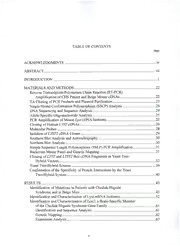
Characterization of the Chediak-Higashi syndrome gene in human and mouse PDF
Preview Characterization of the Chediak-Higashi syndrome gene in human and mouse
CHARACTERIZATIONOFTHECHEDIAK-HIGASHISYNDROMEGENEIN HUMANANDMOUSE By VELIZART.TCHERNEV ADISSERTATIONPRESENTEDTOTHEGRADUATESCHOOL OFTHEUNIVERSITYOFFLORIDAINPARTIALFULFILLMENT OFTHEREQUIREMENTSFORTHEDEGREEOF DOCTOROFPHILOSOPHY UNIVERSITYOFFLORIDA 1998 Copyright1998 by VelizarT.Tchernev Tomyparents ACKNOWLEDGMENTS Theauthorwouldliketothankhismentor,Dr.StephenF.Kingsmore,andthe supervisorycommitteemembers,Dr.M.Wallace,Dr.E.Wakeland,Dr.E.SobelandDr. M.Bubb,fortheirvaluableadviceandencouragement. Theauthor'sappreciationisextendedtoallformerandpresentmembersofDr. Kingsmore'slaboratory,Dr.MariaD.F.S.Barbosa,Dr.VishnuS.Mishra,JohnC.Detter, Dr.ElizabethB.McMurtrie,QuanA.Nguyen,SandraM.Holt,JuanM.Teodoroand AndreaHofig, as well asto Dr. KrishnanNandabalan and Dr. Madan Kumar from CuraGenCorporation,whocontributedtothesuccessfulcompletionofthiswork. TheauthorwishestoexpresshisgratitudetoMs.AnnaV.GueorguievaandMr. NathanS.Collierfortheirkindnessandcontinuoussupport. Finally,butmostimportantly,theauthorwouldliketothankhisparentsLilia JelevaandTzvetanTchernevfortheirlovingcareandguidance,hisbelovedwifeRalitza Gueorguievaforherinvaluable supportandinspiration, andhis fellow-players Ivajlo Kortezov,RadaKortezova,LudwigLubih,AnastasAssenovandIsakBerahafortheir truefriendshipandthought-provokingconversations. IV TABLEOFCONTENTS page ACKNOWLEDGMENTS iv ABSTRACT vii INTRODUCTION 1 MATERIALSANDMETHODS 22 ReverseTranscription-PolymeraseChainReaction(RT-PCR) AmplificationofCHSPatientandBeigeMousecDNAs 22 TACloningofPCRProductsandPlasmidPurification 23 Single-StrandConformationPolymorphism(SSCP)Analysis 24 DNASequencingandSequenceAnalysis 24 Allele-SpecificOligonucleotideAnalysis 25 PCRAmplificationofMouseLystcDNAIsoforms 25 CloningofHumanZESTcDNAs 26 MolecularProbes 28 IsolationofLYST2cDNAClones 29 SouthernBlotAnalysisandAutoradiography 30 NorthernBlotAnalysis 30 SimpleSequenceLengthPolymorphism(SSLP)PCRAmplification 31 BackcrossMousePanelandGeneticMapping 31 CloningofLYSTandLYST2BaitcDNAFragmentsinYeastTwo- HybridVectors 32 YeastTwo-HybridScreens 36 ConfirmationoftheSpecificityofProteinInteractionsbytheYeast Two-HybridSystem 40 RESULTS 43 IdentificationofMutationsinPatientswithChediak-Higashi SyndromeandinBeigeMice 43 IdentificationandCharacterizationofLystmRNAIsoforms 52 IdentificationandCharacterizationoiLyst2,aBrain-SpecificMember oftheChediak-HigashiSyndromeGeneFamily 61 IdentificationandSequenceAnalysis 61 GeneticMapping 62 ExpressionAnalysis 67 IdentificationofProteinsthatInteractwiththeCHSProteinandwith LYST2,UsingaYeastTwo-HybridApproach 71 IP-1(ESTcg50136.f6,APPENDIX,Sequence13) 76 IP-2(ESTAA010799,APPENDIX,Sequence14) 77 IP-3(ESTcg50136.cl0,APPENDIX,Sequence15) 77 IP-4(ESTcg50136.a7,APPENDIX,Sequenced) 78 IP-5(ESTcg50175.c7,APPENDIX,Sequence17) 79 IP-6(ESTcg50138.g5,APPENDIX,Sequence18) 80 IP-7(ESTcg50173.dl0,APPENDIX,Sequence19) 81 IP-8(ESTcg50175.h7,APPENDIX,Sequence20) 82 IP-9(ESTKIAA0192,APPENDIX,Sequence21) 83 IP-10(ESTcg50136.a5.b,APPENDIX,Sequence22) 83 IP-11(ESTcg51287.dl0,APPENDIX,Sequence23) 84 IP-12(ESTcg49432.h3.b,APPENDIX,Sequence24) 85 IP-13(ESTcg50175.cl1,APPENDIX,Sequence25) 86 DISCUSSION 88 IdentificationandCharacterizationofLystmRNAIsoforms 88 IdentificationofMutationsinPatientswithChediak-Higashi SyndromeandinBeigeMice 92 IdentificationandCharacterizationofLystl,aBrain-SpecificMember oftheChediak-HigashiSyndromeGeneFamily 94 IdentificationofProteinsthatInteractwiththeCHSProtein,Usinga YeastTwo-HybridApproach 98 APPENDIX SEQUENCESOFMOLECULESINTERACTINGWITHLYST ANDLYST2 123 BIBLIOGRAPHY 177 BIOGRAPHICALSKETCH 192 VI AbstractofDissertationPresentedtotheGraduateSchool oftheUniversityofFloridainPartialFulfillmentofthe RequirementsfortheDegreeofDoctorofPhilosophy CHARACTERIZATIONOFTHECHEDIAK-HIGASHISYNDROMEGENEIN HUMANANDMOUSE By VelizarT.Tchernev December1998 Chairman:StephenF.Kingsmore MajorDepartment:Pathology,ImmunologyandLaboratoryMedicine Chediak-Higashisyndrome(CHS)isanautosomalrecessive,immunedeficiency disorderofhumanandmouse(beige,bg)thatischaracterizedbyabnormalintracellular proteintransporttoandfromthelysosome/lateendosome.Recentreportshavedescribed thepositionalcloningofhomologousgenes,LYSTandLyst,thataremutatedinhuman CHSandinbgmice,respectively.However,sincetheencodedproteinswerenoveland unlike any of the molecules previously implicated in vesicular trafficking, their identificationdidnotproveimmediatelyhelpfulinestablishingtheprecisemechanism wherebyCHSdysregulatesproteintransport.Therefore,themaingoalofthisdissertation was to characterize the Chediak-Higashi gene and its products inmore detail using functionalgenomicsapproaches.Wedemonstratedthateachofthepreviouslyreported bggenesequencesarederivedfromasinglegenewithalternativelysplicedmRNAs. Alternativesplicingresultsinbggeneisoforms(Lyst-landLyst-IT)thatcontaindifferent vn 3' regions. Similarly to mouse, the human mRNA isoforms arise from incomplete splicingandretentionofatranscribedintronthatencodestheC-terminusofthepredicted LYSTprotein.Additionalsplicingcomplexityofsmallerisoformsexists.TheLyst-lll isoform lacksexonsa and p\whileinLyst-YV, exons a, P andyare absent. Novel mutationswereidentifiedwithinthecodingdomainofLYSTinseveralCHSpatientsand bgalleles.Interestingly,allbgandLYSTmutationsidentifiedtodatearepredictedto resultineithertruncatedorabsentproteins.Mutationandexpressionanalysessuggested thatdefectsinthefull-lengthmRNAalonecanelicitChediak-Higashisyndromeandthat expressionofthesmallerisoformalonecannotcompensateforlossofthelargestisoform. Wehavealsoidentifiedanovelgeneinhuman(LYST2)andmouse(Lyst2)thatappears tobearelativeoftheCHSgene,basedonsequencesimilarity,predictedproteinstructure andonsimilartranscriptsize.ComparisonoftherelativeabundanceofLYST2andLYST mRNAssuggeststhatLYST2isexpressedabundantlyonlyinbrainandthereforeitmay representabrain-specificmemberoftheCHSgenefamily.Usingamodifiedyeasttwo- hybridsystem,ahumancDNAlibrarywasscreenedwithbaitsfromthecodingdomains ofZTSTandLYST2.Severalproteins,whichplayimportantrolesinproteintransportand signaltransduction,suchas14-3-3,caseinkinaseII,calmodulinandHrs,werefoundto interactwithLYSTand/orLYST2.Manyoftheinteractingproteinscouldbelinkedina commonpathwaythatregulatesvesiculartraffickinganddegranulation. vin INTRODUCTION Chediak-Higashisyndrome(CHS)isaprimaryimmunodeficiency,characterized bysevererecurrentinfections(Blume&Wolff,1972),partialalbinism(Windhorstetal, 1968),nervoussystemabnormalities(Misraetal, 1991),highincidenceofmalignancy (Hayakawaetal,1986)andpredispositiontobleeding(Meyersetal,1974).Eighty-five percentofpatientsundergoanacceleratedlymphoma-likephase,characterizedbyfever, hepatosplenomegaly, lymphadenopathy, pancytopenia, coagulopathy and widespread lymphohistiocytic organ infiltrates. Thiscomplication is fatal inthe absence ofbone marrowtransplantation. Thefirst3casesofChediak-HigashisyndromewerereportedbyBeguez-Cesarin 1943,thenonecasebySteinbrinkin 1948,andonecasebyHigashiin1954.Chediak publishedcertainaspectsofBeguez-Cesar'scasesin1952,andSatoin1955recognized thesimilaritiesbetweenChediak'sandHigashi'sdata,inventingtheeponym"Chediak- Higashisyndrome."Exceptfortheoccasionalusageofsinglenamesorcombinationsof the above authors' names, the disease has been most commonly referred to as the Chediak-Higashisyndrome. Approximately150casesofCHShavebeenreportedintheliterature.Malesand femalesareaffectedequally. ThemeanageofdeathofCHSpatientsis6years. The Chediak-Higashisyndromeoccurswithalowfrequencythroughouttheworld.Europe, 1 AmericaandJapanaretheareasfromwhichthemajorityoftheknowncaseshavebeen described.Whilemostofthereportsdealwithisolatedcases,auniqueclusterofChediak- Higashi syndrome patients has also been published (Ramirez-Duque et al, 1982). Fourteencases ofCHS were found in 12 families living inadefined and relatively isolatedgeographicalarea(Pregonero)intheVenezuelanAndes.Thepatientswerepre- schoolchildrenexceptone11-year-oldfemale.Sixofthepatientsweremale.Allshowed the sametypical clinical characteristics ofthe syndrome. SinceCHS isanautosomal recessive disease (Sato, 1955), the existence ofthis high-frequency cluster ofCHS patients inarestricted regioncould be explained by afoundereffect in an isolated populationwithinbreeding. Thepresenceofgiant,perinuclearvesicleswithproteinmarkerscharacteristicof late endosomes andmature lysosomes is pathognomonic for CHS (Burkhardt etal, 1993). The organelles are abnormal both in size (enlarged) and in cytoplasmic distribution(perinuclear).Whilethelateendosomal/lysosomalcompartmentisuniformly affectedinCHS,thehistologicaldesignationofaffectedorganellesvariesbycelltype: melanosomesareaffectedinCHSmelanocytes,whilesecretorygranulesareaffectedin CHSneutrophils,eosinophils,mastcells,cytolyticT-cells,proximalrenaltubules,and lysosomesareaffectedinmonocytesandfibroblasts.Thegiantorganellesarethoughtto resultfromdysregulatedfusionofprimaryendosomesandlysosomes(Burkhardtetal., 1993; Willingham et al, 1981). The morphological abnormalities ofbg and CHS lysosomesareaccompaniedbycompartmentalmis-sortingofproteinssuchaselastase,(3- glucuronidase,andcathepsinG(Holcombeetal.,1994).
